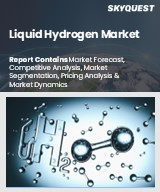
액체 수소 세계 시장 규모는 2023년 412억 달러로 평가되었고 예측 기간(2025년-2032년) CAGR은 5.6%로, 2024년 435억 1,000만 달러에서 2032년까지는 672억 8,000만 달러로 성장할 전망입니다.
세계 액체 수소 시장은 급속한 기술 발전, 청정 연료에 대한 정부 보조금, 진화하는 에너지 정책으로 인해 크게 성장하고 있습니다. 탈탄소화 노력과 수소 인프라 개발은 미래 정부의 우선순위를 형성하는 데 있어 매우 중요합니다. 액체 수소는 대규모 에너지 저장, 운송 및 항공 분야에서 점점 더 많은 잠재력을 인정받고 있습니다. 지속 가능한 에너지 솔루션에 대한 관심이 높아진 배경에는 이산화탄소 배출량을 줄이고 에너지 효율을 높이기 위한 광범위한 노력이 있으며, 액체 수소는 청정 에너지 시스템으로의 전환에 중요한 역할을 할 수 있습니다. 다양한 산업 이해관계자들이 이러한 변화에 적응함에 따라 액체 수소에 대한 수요가 증가하고 시장 기회는 더욱 확대될 것으로 예측됩니다.
Global Liquid Hydrogen Market size was valued at USD 41.2 billion in 2023 and is poised to grow from USD 43.51 billion in 2024 to USD 67.28 billion by 2032, growing at a CAGR of 5.6% during the forecast period (2025-2032).
The global liquid hydrogen market is witnessing significant growth driven by rapid technological advancements, supportive government subsidies for clean fuels, and evolving energy policies. Decarbonization efforts and the development of hydrogen infrastructure are pivotal in shaping future governmental priorities. Liquid hydrogen is increasingly recognized for its potential in large-scale energy storage, transportation, and aviation sectors. This growing emphasis on sustainable energy solutions reflects a broader commitment to reducing carbon emissions and enhancing energy efficiency, positioning liquid hydrogen as a key player in the transition towards cleaner energy systems. As stakeholders in various industries adapt to these changes, the demand for liquid hydrogen is expected to rise, further bolstering market opportunities.
Top-down and bottom-up approaches were used to estimate and validate the size of the Global Liquid Hydrogen market and to estimate the size of various other dependent submarkets. The research methodology used to estimate the market size includes the following details: The key players in the market were identified through secondary research, and their market shares in the respective regions were determined through primary and secondary research. This entire procedure includes the study of the annual and financial reports of the top market players and extensive interviews for key insights from industry leaders such as CEOs, VPs, directors, and marketing executives. All percentage shares split, and breakdowns were determined using secondary sources and verified through Primary sources. All possible parameters that affect the markets covered in this research study have been accounted for, viewed in extensive detail, verified through primary research, and analyzed to get the final quantitative and qualitative data.
Global Liquid Hydrogen Market Segments Analysis
Global Liquid Hydrogen Market is segmented by Production Method, Distribution Method, End Use and region. Based on Production Method, the market is segmented into Coal Gasification, SMR and Electrolysis. Based on Distribution Method, the market is segmented into Pipelines and Cryogenic Tanks. Based on End Use, the market is segmented into Transportation, Chemical and Others. Based on region, the market is segmented into North America, Europe, Asia Pacific, Latin America and Middle East & Africa.
Driver of the Global Liquid Hydrogen Market
The demand for liquid hydrogen is significantly bolstered by the rising investments in space exploration initiatives globally. As countries enhance their launch capabilities, exemplified by successful cryogenic engine tests, the need for efficient and sustainable fuel sources becomes increasingly critical. This commitment to advancing space technology is evident in initiatives such as the European Space Agency's development of the Ariane 6 rocket launcher, which transitions from conventional grey hydrogen to greener alternatives, while still recognizing the crucial role of liquid hydrogen in propulsion systems. This shift highlights the industry's focus on sustainability while meeting the growing requirements of space missions.
Restraints in the Global Liquid Hydrogen Market
The production and liquefaction of hydrogen involves significant expenses, which serve as a substantial hindrance to the global liquid hydrogen market. Generating green hydrogen through electrolysis demands a considerable amount of energy, particularly when contrasted with the more cost-effective grey hydrogen derived from fossil fuels. Furthermore, the process of cooling hydrogen to reach -253°C necessitates extensive energy consumption and specialized, expensive cryogenic equipment. These factors create a challenging economic landscape, ultimately limiting the expansion and adoption of liquid hydrogen within the energy sector, as stakeholders seek more affordable and efficient alternatives.
Market Trends of the Global Liquid Hydrogen Market
The global liquid hydrogen market is experiencing a notable trend towards the integration of green hydrogen into supply chains, driven by the urgent need for decarbonization. This shift involves the use of renewable energy sources, such as solar and wind, for hydrogen production through electrolysis, facilitating the liquefaction and distribution processes. Countries are strategically investing in eco-friendly hydrogen hubs that enable large-scale production and local liquefaction, making projects more sustainable and eligible for clean energy subsidies, particularly in North America and Europe. This trend not only boosts investor interest but also significantly enlarges the liquid hydrogen market size, reflecting a growing commitment to sustainable energy solutions.